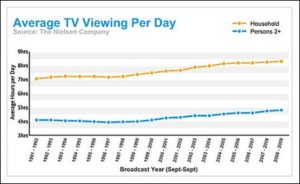Television Is King
Television Is King
In the last post on this website I introduced the topic of what we can learn from television that can help our preaching. Stop preaching and start communicating was our theme. In this post we continue this subject by looking at the fact that television is king in the communication world today.
A Post-Literate World
Many people today refer to our time in history as post-literate, and the statistics support that idea. I am a subscriber to a newspaper in a medium-sized, mid-western community here in the United States. A few years ago the paper that I read acknowledged their declining readership, and went to a new system. Print copies of the paper are available only on Tuesdays, Thursdays and Sundays. All other days are available only through the web.
The reason for this change, of course, was that readership is down, and it is too costly to produce a print copy every day.
So how do people get their news? More than 50% report that they get their news through the television or internet. Television is king when it comes to communication.
What Does This Mean for Preaching?
 I think Haddon Robinson, preaching expert, put it well in a talk at Denver Seminary way back in 1991. He said, “The way in which people get ideas, the way in which they shape their ideals, comes not because they read books, but because they see it. They visualize it. It’s on television….” (Haddon Robinson, “Our Mission in a Changing World”, Denver Seminary, 4 January, 1991) Robinson wrote that back in 1991. Some things have changed in that the younger generation gets more of its information through social sites on the internet, but overall, 57% of people in the US still get most of their news through the tv. Obviously, television is king in the communication world.
I think Haddon Robinson, preaching expert, put it well in a talk at Denver Seminary way back in 1991. He said, “The way in which people get ideas, the way in which they shape their ideals, comes not because they read books, but because they see it. They visualize it. It’s on television….” (Haddon Robinson, “Our Mission in a Changing World”, Denver Seminary, 4 January, 1991) Robinson wrote that back in 1991. Some things have changed in that the younger generation gets more of its information through social sites on the internet, but overall, 57% of people in the US still get most of their news through the tv. Obviously, television is king in the communication world.
This has huge implications for those of us who preach. This is the way Robinson put it in that same speech: “This means a great deal to people involved in communication. It means that if you believe the way you’re going to communicate your message to men and women today is by putting it into print, you don’t understand the future out there. And that has shaped the way we think. We see in images. We visualize things. It affects the way we preach. It affects the hard core of communication. And I believe the thing that shapes our values most in our society is television.” (Ibid)
What Do We Do About It?
So what do we do about it? I’ve written about that before in this blog. Back in January of 2019 I wrote a post with the title, “Learn to Speak in Pictures“. The same point applies today when we consider that television is king in the communication world. In 2008, the average household spent 8 hours, 21 minutes with at least one of multiple televisions on. The television, with its moving pictures, has become the way people shape their views of the world around them.
So, what do we do about it? We need to learn how television operates. We need, as I said in the last post of this blog, to stop preaching and to start communicating. For many people, preaching is negative, as in “Stop preaching at me!” But television is considered positively. People believe that what they see on tv reflects reality, and they react accordingly.
Not more tv watching and movie going

John Piper
I don’t mean, here, that we should watch tv and movies to get our sermon ideas. John Piper, well-known and influential pastor in the US, has written a blog post about why he doesn’t have a tv, and doesn’t go to movies. Here’s the link to that post. My point is that we can learn some principles from how television goes about identifying and influencing the audience. So it’s more than just learning to speak in pictures. It is learning the tricks of the trade that can be transferred to a monologue presentation.
Stay tuned. We’ll pick up this theme in the next post.




Leave a Reply
Want to join the discussion?Feel free to contribute!